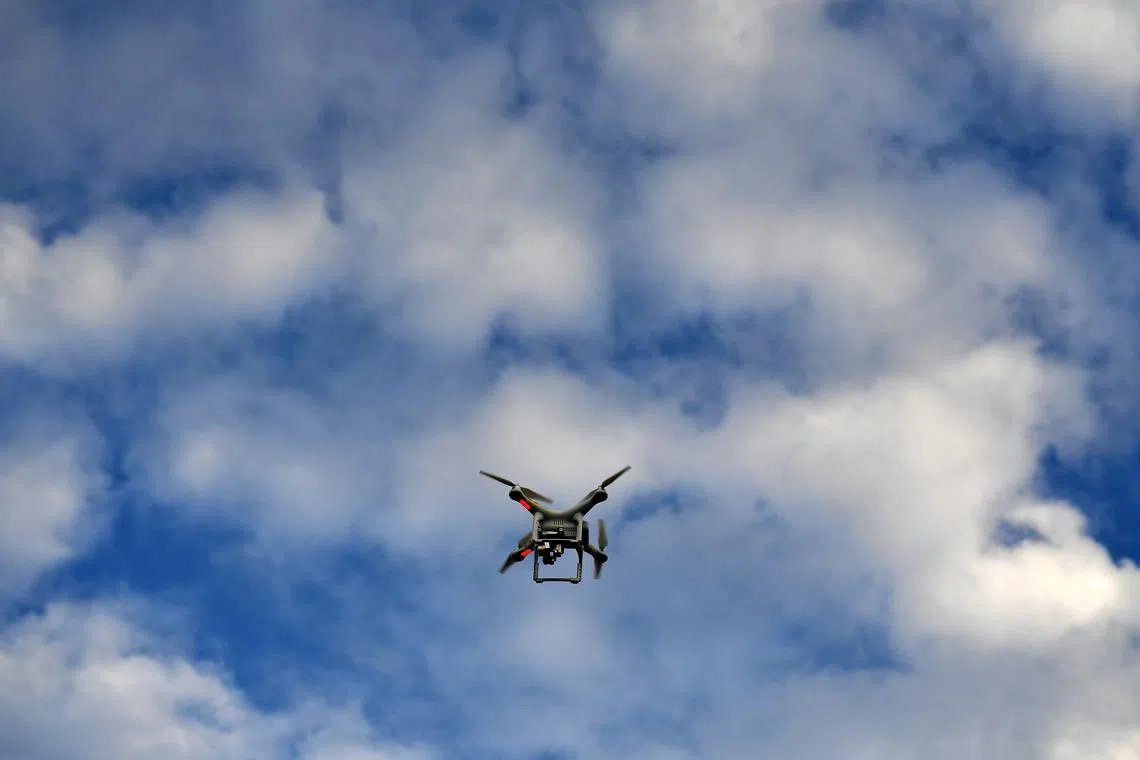Multiple unmanned aircraft can share a digital licence plate under new rule in Dec 2025: CAAS
Sign up now: Get ST's newsletters delivered to your inbox

The digital licence plate transmits information about the aircraft’s position and the location of its operator.
PHOTO: ST FILE
Follow topic:
SINGAPORE – Owners of multiple unmanned aircraft (UA) will be able to use a single digital licence plate, instead of one per UA, when new regulations take effect in December 2025, the Civil Aviation Authority of Singapore (CAAS) said on Nov 12.
Making the digital licence plate transferable for UA without built-in remote identification capabilities is one suggestion that CAAS has accepted, following a month-long public consultation that ended on Oct 1. It received 236 responses from the public, as well as community and industry groups.
The digital licence plate
CAAS said in September that from Dec 1, 2025, UA users must comply with new regulations requiring UA weighing more than 250g to have B-RID.
A UA is considered to be equipped with B-RID when it has either built-in B-RID capability or a B-RID module attached to it.
In Singapore, the majority of new UA in the market and more than half of UA registered with CAAS in 2024 are equipped with built-in B-RID modules.
According to the aviation authority, some respondents in the public consultation suggested that certain UA users be exempt from the requirements.
But the authority rejected this, saying it was “unable to grant any exemptions” because B-RID “is needed to enhance aviation and public safety and security”.
CAAS, however, said it would “consider waivers for certain circumstances where the standard B-RID requirements cannot be met, or it is difficult to do so”.
Mr Maran Paramanathan, director of unmanned systems policy, regulations and operations at CAAS, told The Straits Times that the B-RID requirement will also apply to tourists and foreigners.
When asked about the circumstances under which waivers may be granted, he said the authority would consider waivers if the size and design of a UA - especially for some that weigh slightly above 250g - are such that there is no space to install the B-RID safely.
The authority is working with UA manufacturers on a list of B-RID-compliant models and B-RID modules that meet its requirements. The list will be published on the CAAS website in December, it said.
There was a suggestion on raising the weight threshold for UA compliance with the B-RID requirement.
CAAS noted that “drones weighing more than 250g, when crashed onto a person, can result in serious injuries, including fatality”.
“For safety reasons, the weight threshold of 250g for B-RID requirements should be maintained,” it said.
Mr Farhan Tahir, administrator of the Universal Drones Singapore Facebook hobby group – which has about 8,100 members – said that making B-RID transferable is “a good move (that will benefit) users with multiple drones”.
However, he expressed concern about the cost of maintaining a B-RID unit for UA that do not have B-RID built in.
This concern was echoed by other members in the group, he said.
Mr Farhan suggested that CAAS “provide a warranty period for any hardware defects and repair any damaged units”, or use user-replaceable batteries.
Currently, users with an operator permit who use the FlyItSafe mobile app while operating UA are exempt from the B-RID requirement.
The app allows UA operators to monitor UA flights to ensure they are within permitted areas and to prevent unintentional breaches into non-permitted zones.
B-RID is also not required if the UA is operated indoors or in an enclosed environment.
B-RID uses Wi-Fi and Bluetooth technology to share information such as the UA’s position, serial number and the operator’s identification reference number.
“The information that is broadcast from the UA can be received within transmission range by government agencies to identify the UA in flight for safety and security purposes,” CAAS previously told ST.
The number of registered UA in Singapore has ballooned from 8,205 in December 2020 to 24,567 in July 2024.


